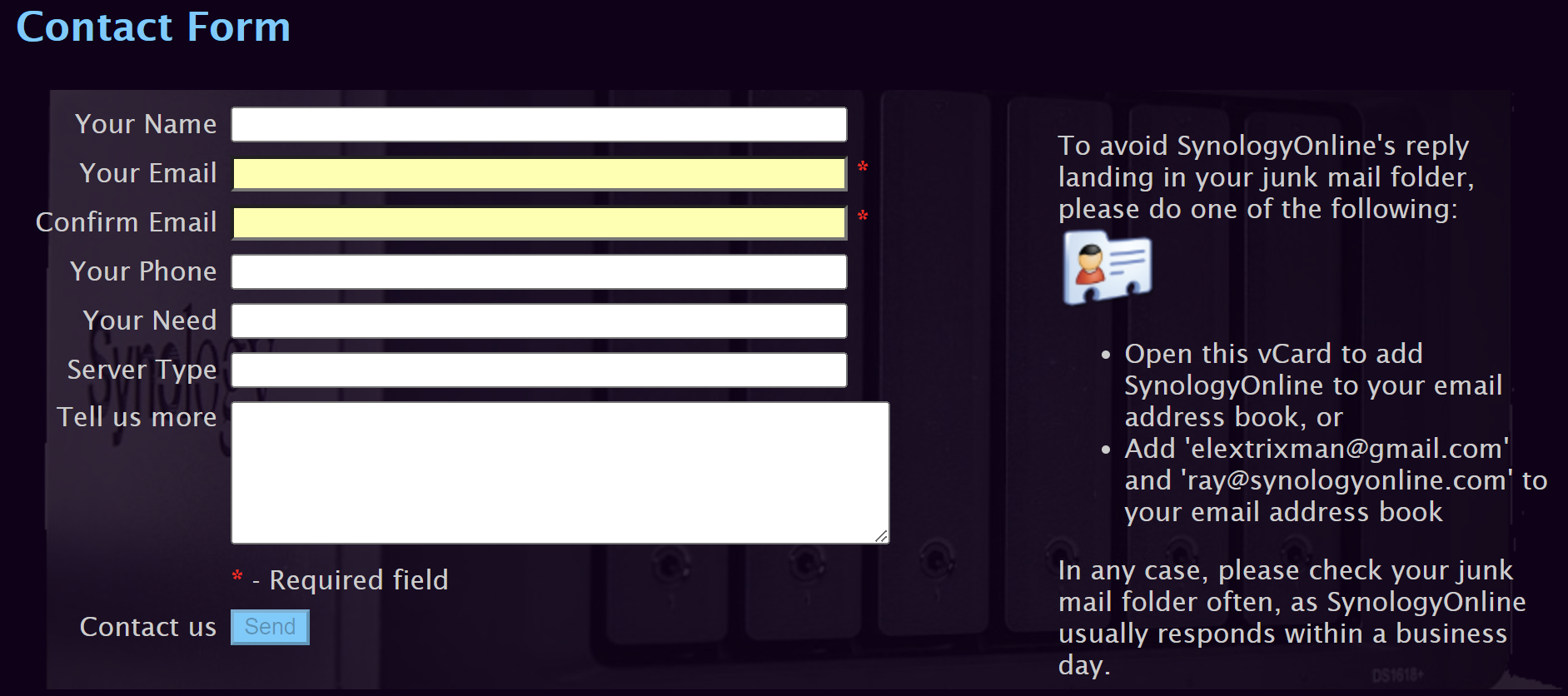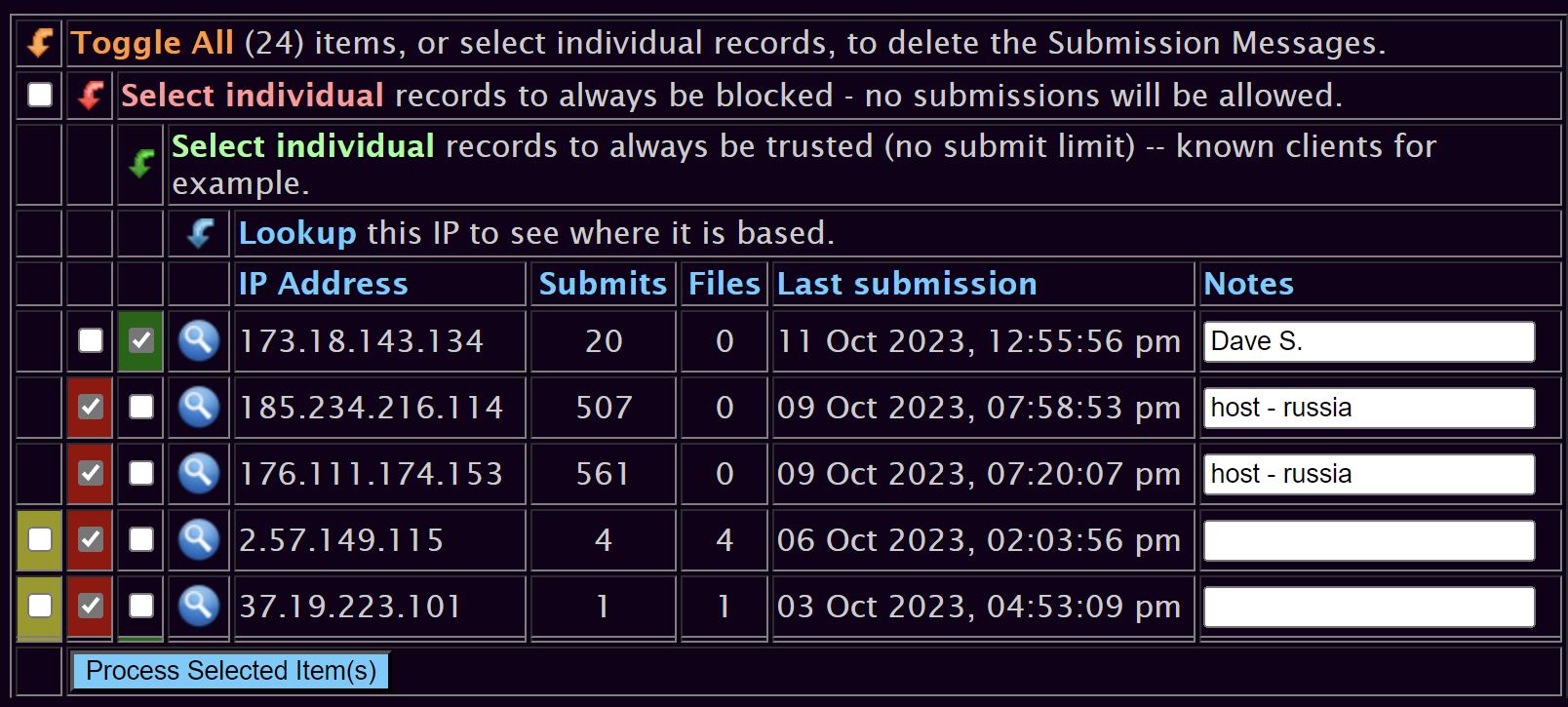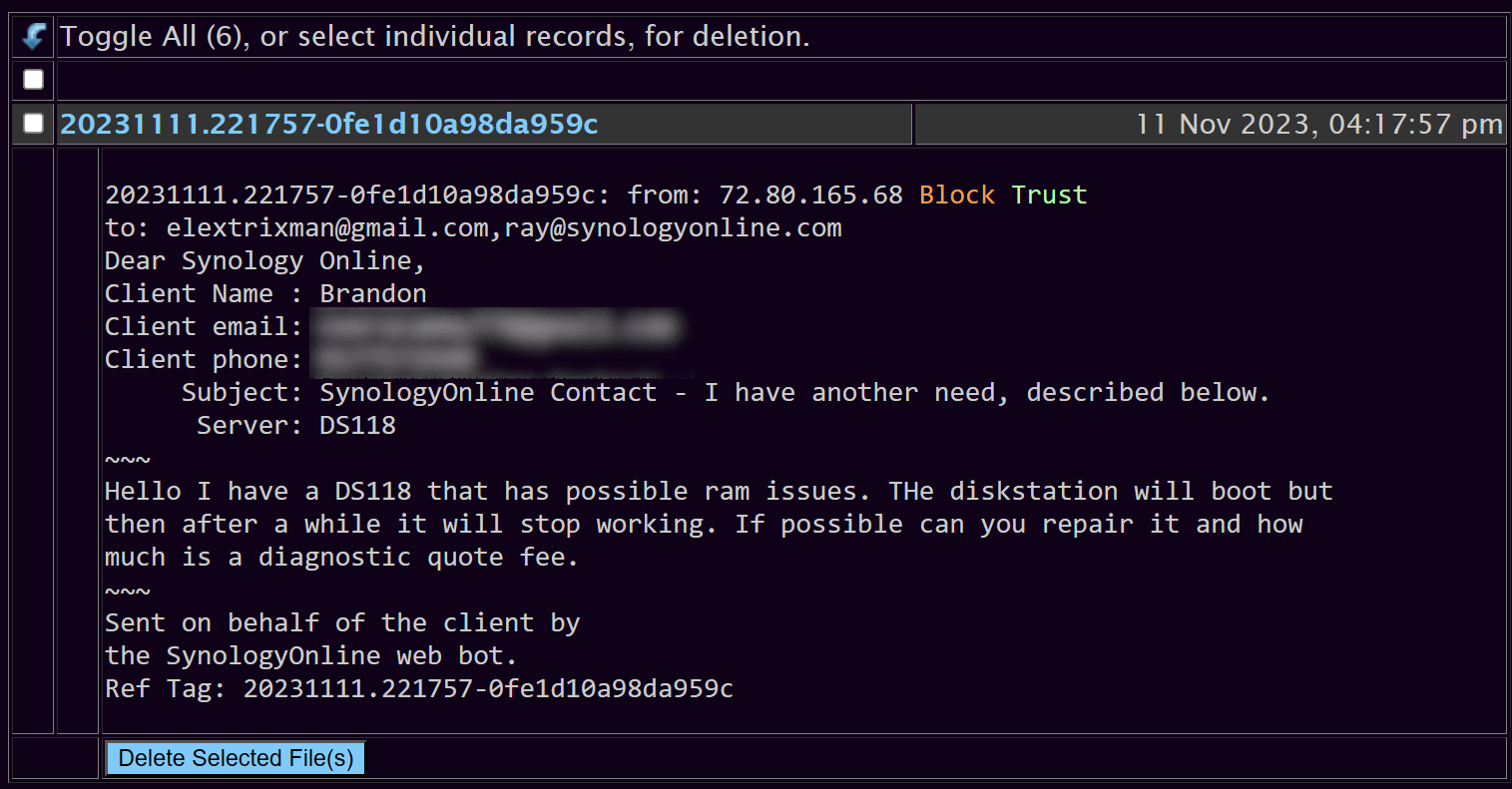
|
SynologyOnline.Com |


|
| Admin Console Help |
Admin Console Help
The admin console should be a regular place to visit - even if only for moments. To understand the best practices, you may want to set this browser window alongside the actual Admin Console, so you can read about the features and see them in practice.
NOTE: The admin console has a logoff button, located in the top-right just below the dark-lite theme icons.
Contact Form
Here are some brief points about the contact form on the main page.

It is important to note that if a visitors' IP address is being 'Blocked', as designated in the IP Submission Cache (see below), that they will not even see the Contact form. Instead, a brief message about their IP being used by a spam bot will appear. The right hand side of the form, with the textual email addresses, will still be shown.
Your Name is a freeform field where we hope the user enters their name.
Your Email is also a freeform field, however there is some basic sanity checking of the entry to ensure it looks like a legitimate email.
Confirm Email is a simple check that they can enter their email twice the same - improving the chance that they did not misspell it.
Your Phone is naturally a place where they may enter their phone number.
Your Need is a combination free-form and pull-down field. They can Choose from some standard 'needs', or they may freeform enter whatever they want.
Server Type similarly offers both a list of common server types as well as a freeform field.
Tell us more is the catch-all for anything else they would like to say.
Contact us contains the 'Send' button. This button is only enabled after the user successfully fills in both email fields.
Admin - Submission Pending
As the user interacts with the admin console, they will make changes in the IP Submission Cache form. The change could be directly caused, by interacting with the form. The change can also be caused by interacting with individual Contact Submissions. If there is any change, a reminder banner appears at the top of the browser window. The small icon at the top-left pulses gently to remind you. You can click on the pulsing icon to navigate to the IP Submission Cache form, regardless of where on the page you may be.

Admin - IP Submission Cache
The IP Submission Cache is created by reviewing all of the form submissions. It shows the IP address, the total number of submissions from this IP, followed by the number of submissions still saved as files (which are listed individually below), the date and time of the most recent submission, and finally a short notes field. The whole list is ordered from the most recent down to the oldest.

Very importantly, this form offers the option of removing and blocking submissions - based on the IP address used.
Column 1 - Delete lets you select, for deletion, all IP addresses which have a submission record on file. You can then press the button at the bottom of the form to process selected items, which will delete every saved submission.
Column 1 to the left of each record, you can select for deletion all of the saved submissions from that specific IP address. You will likely do this for the spam bots, but you may also want to do this for those legitimate submissions that you know you have already received in email. If there are no submissions on file, this field will be blank.
NOTE: This does not remove the 'count' of submissions, only the submission text - which is worthless if it was from a bot.Column 2 - Block let's you flag an IP address you want to block. When this IP Address visits this site, they will not even be presented with a submission form. It will instead declare the reason they are blocked. You might also consider adding a short note in the far right column to remind yourself of this bot.
Column 3 - Trust let's you flag an IP address you trust (typically by reviewing the email you received). A business for instance, may contact you more than once. In the example above, one record was checked (notice the checkmark surrounded by the green highlight). In addition to the check, a short note was captured - as a reminder why you trust them. Do keep in mind that occasionally IP addresses change and a business may have more than one address.
NOTE: If you check both the 'Block' and the 'Trust' columns, the trust option overrides the block. You can see an example of this is the graphic above.Column 4 - Lookup provides an IP lookup for this record. This can help identify where in the world this IP is being hosted.
Column 5 - IP Address shows the IP that was used to submit the form. Just to the left of the IOP is a small icon for doing an internet lookup on that IP. This may give you a better idea if this is a bot attacking.
Column 6 - Submits shows the number of total submissions from that IP address. You should also have an email in your inbox for each, up to the submission limit setting in the configuration file.
NOTE: Where you see a record with many submissions, it is likely a bot attacking and the red highlight may help you come to that conclusion. Check the date and time of its most recent submission to see if it is old - you may want to delete them all.Column 7 - Files shows how many submission files are still saved and can be reviewed further below.
Column 8 - Last submission shows the date and time of the most recent submission from this IP.
Column 9 - Notes is where you can place a small note reminding you of the source of a client IP, or as a reminder of the untrustworthy IP.
Admin - Contact Submissions
The Contact Submissions section can be used to review the submissions. Every submission, whether you want it (from a bot) or not, is saved to the file system and available here for review.
If you select any specific items in this section, be sure to go to the bottom of this section where you can submit the changes. Navigating away will not automatically apply the changes.

If you see a bunch of submissions that are junk, and all from the same IP address, then you could take note of the "from: IP Address", then to jump up to the 'IP Submission Cache' section, find that IP and check the box to delete them all. But there are better ways!
The top-most checkbox in this section gives you the option to select ALL of the individual records and delete them.
The next option in this section is a checkbox to delete the individual submission.
The next most important feature is just to the right of the IP address, where you can see Block and Trust. If you hover over each, you'll see what they do when you click it to update the IP Submission Cache form.
- The Block action automatically selects two items - the delete all files, AND the block this IP.
- The Trust action selects the trust item and if the notes field is empty, it adds 'client' to it.
Selecting either also reveals a top-of-the-page banner, reminding you to finish the job by submitting the IP Submission Cache form (not the submit on the contact submissions area).
This section can have other value. If, for example, the web host mail system broke, and you noticed that you haven't received any email lately, all is not lost. As long as the web site itself remains functional, all those submissions will be available here for your review.
NOTE: If you want to remove all stored email messages, select the checkbox at the top of this section and the 'Delete Selected File(s)' button at the bottom.